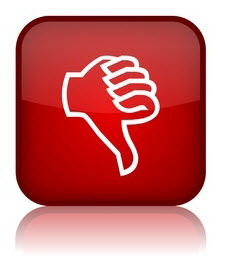In May of this year, DSM-5 will celebrate its third birthday. I’ve been using the manual for two years now, and I’ve reviewed it thoroughly. So here’s my assessment of its plusses and minuses, from a clinical perspective. I’ve categorized my comments as “Thumbs Up” and “Thumbs Down.”
It took a while for the furor regarding the changes incorporated into DSM-5 to subside as supporters and detractors eagerly faced off, defending their positions with fervor. Change is hard and “new” is unfamiliar, but DSM-5 is not a radical departure for psychiatric diagnosis, much less any sort of revolutionary change in that it is clearly the offspring of its predecessor, DSM IV. Changes are mostly procedural, so redefining and documenting client problems according to new templates is required.
What hasn’t changed with each subsequent manual update is that clinicians aren’t using the criteria as intended. Very veritable studies indicate that some clinicians aren’t evaluating criterion in order, and are pinning criteria to the client instead of pinning the client to criteria. Among non-psychiatric practitioners (PCPs), the DSM was used in only 25 percent of patient visits in which a psychosocial problem was recognized. And 60 percent of PCPs reported NO use of the DSM at all. Pet diagnoses still abound and the book often serves as no more than a vehicle for finding the most reimbursable diagnosis.
Changes from IV to 5:
 Thumbs Up
Thumbs Up
- Giving up the multiaxial system. With the five-axis classification gone, diagnoses are just recorded in a list, with the principal diagnosis listed first. It’s a simpler approach and doesn’t require us to rate each client according to criteria other than their primary psychological disorders. And the word “axis” just didn’t fit or make sense. Also personality disorders and mental retardation were a strange combination. Replacing “mental retardation” with “intellectual disability” is less stigmatizing.
- Eliminating Autistic Disorder as a diagnosis. This one’s controversial for sure, but its replacement, Autism Spectrum disorder is sufficient because the spectrum concept is useful for the family umbrella of autistic disorders. This means Asperger’s is gone, but most of those with a well-established DSM IV diagnosis of Asperger’s should meet criteria for autism spectrum.
- The same 10 personality disorders have been retained.
- OCD gets its own category. OCD is not and never was an anxiety disorder. Its basis is a neurological “short circuit,” making it difficult for those with OCD to control primitive urges and instincts.
- PTSD is now a part of a new grouping called: “Trauma and Stressor-Related Disorders.”Anxiety symptoms have always occurred downstream from the primary symptoms of re-experiencing, hyperarousal and avoidance. Also, a new symptom cluster which comprises negative alterations in mood and cognition has been added. Emphasis on these mood and cognitive changes better reflect how people with PTSD often feel when exposed to trauma.
- The five subtypes of schizophrenia (paranoid, disorganized, catatonic , undifferentiated and residual) have been eliminated. Do you miss them? I most certainly don’t.
 Thumbs Down
Thumbs Down
- Mild Neurocognitive Impairment. Adding this makes it all but impossible to distinguish what is actually impairment, from the normal forgetting process associated with aging, thus pathologizing people with slight memory problems. We’re getting closer and closer to establishing a biomarker for Alzheimer’s, so why not wait until we have something more definitive instead of having older adults do all sorts of testing that lacks specificity.
- Elimination of the Bereavement exclusion. Major depressive disorder can now be diagnosed after just 2 weeks of sadness, dysphoria, insomnia, and anergia in the bereaved. This puts grief on the clock, so to speak, which is completely unnecessary. Too often what is called major depressive disorder is not major, not depressive and not a disorder; so the door to antidepressant prescribing swings open even wider.
- Generalized anxiety disorder. The duration of symptoms for GAD have been reduced from 6 months to just 3 months. Why? I thought waiting longer better helped define whether anxiety symptoms were chronic or not? As a result, physicians and other prescribers can now treat people experiencing no more than the usual ups and downs of everyday life with anxiolytics — and get paid for it.
- Disruptive Mood Dysregulation Disorder. This is one of the best examples of diagnostic inflation ever, and it’s dressed up in clinical jargon that has it sounding far beyond what it represents. DMDD morphed out of the massive over-diagnosis of bipolar disorder in the last decade, and serves as a haven diagnosis for kids primarily exhibiting temper tantrums and irritability who are going through a developmental stage they will eventually outgrow. Oppositional Defiance is more than adequate to cover for such symptoms.
- ADHD. DSM-5 now allows for symptoms to merely “impact” daily activities, not impair them. The thing is I can’t objectify impact as well as I can impairment. Also, the requirement that symptoms appear before age 7 has been changed to before age 12 — ushering in a much larger pool of children subject to this diagnosis. And it’s particularly easier for adults to receive this diagnosis in that it’s hard to distinguish a desire for more concentration and greater cognitive performance from ADHD in older people. And a huge secondary market for the use of stimulants has emerged. Some 30 percent of college students and 10 percent of high school students are using stimulants diverted from people with legal prescriptions.
- Binge Eating Disorder. This disorder seems to be no more than one of occasional overeating. Also the context in which the excessive eating occurs matters, in that a quantity of food that might be regarded as excessive for a typical meal might be considered normal during a celebration or holiday meal. Isn’t overeating irrespective of when or where it happens? Enter the pharmaceutical industry. The psychostimulant Vyvanse is now FDA-approved for BED. Stimulants have consistently proven to be an abject failure when it comes to keeping weight off long-term.
We’ve gone from 12 diagnoses in DSM-I to approximately 200 in DSM-5. In spite of this diagnostic inflation, I do shudder to think what would happen if we clinicians were left to our own devices diagnostically speaking… because the DSM brings a much needed sense of order to what’s otherwise a chaotic mess of mental and behavioral phenomena.
What do you think? How is DSM-5 working for you?
Attribution Statement:
Joe Wegmann is a licensed pharmacist & clinical social worker has presented psychopharmacology seminars to over 10,000 healthcare professionals in 46 states, and maintains an active psychotherapy practice specializing in the treatment of depression and anxiety. He is the author of Psychopharmacology: Straight Talk on Mental Health Medications, published by PESI, Inc.
To learn more about Joe’s programs, visit the Programs section of this website or contribute a question for Joe to answer in a future article: joe@thepharmatherapist.com.